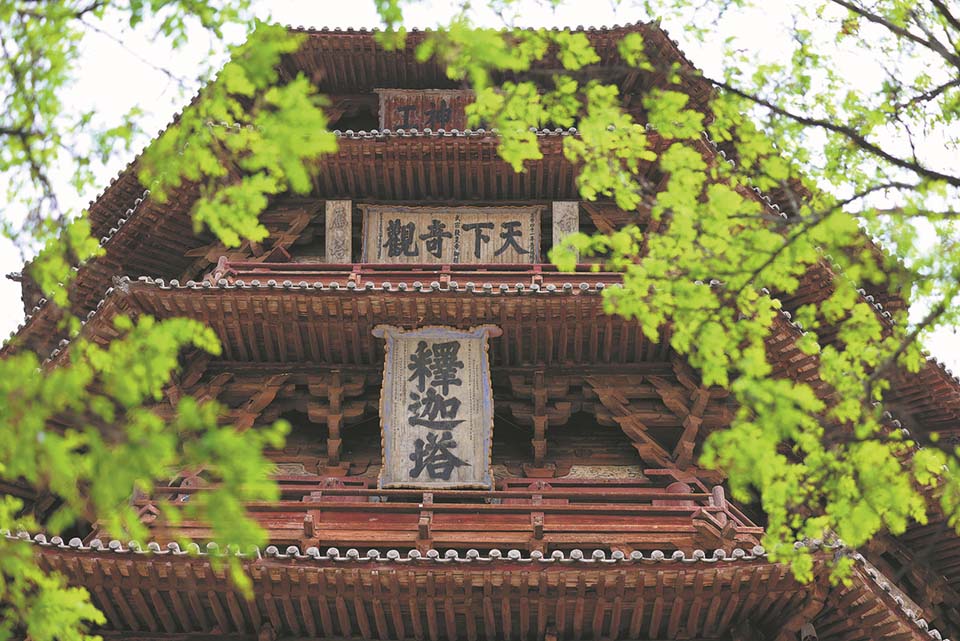July 16, 2024
YINGXIAN – Artificial intelligence is being used to safeguard the country’s oldest and tallest wooden pagoda in North China’s Shanxi province that has withstood natural disasters and human calamities for 968 years.
The technology is being used to enhance the understanding of the 67-meter-tall Sakyamuni Pagoda, visualize its states over time and prepare for restoration work.
AI is not only being used to aid in preserving the pagoda in Yingxian county’s Fogong Temple, but also to enhance the visitor experience by revealing its significant architectural, historical and religious value.
Built in 1056 during the Liao Dynasty (916-1125), the pagoda, built entirely out of wood without the use of nails, has weathered earthquakes, wars and other challenges. Its intricate structure features innumerable mortises and tenons.
As tall as a 20-story building, and with a base diameter of about 30 meters, the pagoda is a remarkable architectural feat.
For its protection, visitors can only enter the first floor and are prohibited from climbing to higher levels. AI technology, however, will allow them to experience the whole pagoda through 3D animation.
When renowned architect Liang Sicheng visited the pagoda for the first time in 1933, he was impressed by the pagoda’s intricate structure and ingenious design. He meticulously measured, surveyed and recorded the building, introducing its treasured relics to China and the world.

A well-preserved Buddha statue in the Sakyamuni Pagoda. PHOTO: CHINA DAILY
In Yingxian, the Sakyamuni Pagoda, also known as the Yingxian Wooden Pagoda, has been the most prominent landmark for generations, but over the years the pagoda has developed a slight lean.
Zhao Yushan, a 63-year-old carpenter in Yingxian, was so taken aback when he first saw the tower as a teenager that he has since dedicated most of his life to replicating it. He’s made numerous scale versions of the pagoda using only the traditional methods of construction, and is currently working on an 8-meter-tall replica.
The pagoda is an octagonal structure comprising nine stories, with five visible from the outside and four concealed within. The Buddhist statues on each story and the paintings adorning the inner walls of the first floor are all creations from the Liao Dynasty.
“We local people believe the pagoda was built by Lu Ban (China’s legendary master carpenter of the Spring and Autumn Period (770-476 BC). The work is beyond manpower,” said a Yingxian resident surnamed Li.
He said that as the pagoda’s lean has increased over the past few years, the need for restoration has become more urgent.

The Sakyamuni Pagoda, also known as the Yingxian Wooden Pagoda, features centuries-old plaques written by renowned calligraphers and emperors. PHOTO: CHINA DAILY
High-tech preservation
In April, a virtual reality program that replicates the pagoda was released by Chinese technology company Lenovo Group and Tsinghua University’s School of Architecture.
Wearing VR glasses, visitors can experience what it would be like to climb the pagoda and explore its interior.
The program has been donated to the county government to become a part of its digital museum.
In February last year, the school began conducting modeling work on the wooden structure inside the pagoda, creating a database of parameters through structural research.
Meanwhile, Lenovo Group is utilizing its AI-generated spatial computing technology, which combines AI, neural radiance fields technology and extended reality technology to construct a digital “twin” of the pagoda.
Besides benefiting tourists, the technologies provide strong technical support for re-creating the complete structure and details of the pagoda.
Mao Shijie, vice-president of Lenovo Group and head of Lenovo Research Shanghai, said the project has utilized cutting-edge AIGC technology, enabling the swift digital reconstruction of the pagoda within 10 hours.
“It was a task that would have taken months using traditional methods,” he said.
By combining AI algorithms with data collected from drones and radar cameras, the project aims to recreate the pagoda’s intricate details accurately, he said.

The Sakyamuni Pagoda of the Fogong Temple in Yingxian, Shanxi province. PHOTO: CHINA DAILY
Professor Liu Chang from Tsinghua University emphasized the importance of fully understanding the pagoda from various perspectives in guiding effective restoration.
He said unraveling the pagoda’s historical transformations and predicting its future state are crucial steps in the preservation process.
Liu hopes to utilize the collected data to analyze and deduce the appearance of the pagoda during different periods.
“I can see how much the pagoda has been compressed and changed over time,” he said.
By revealing the appearance of the pagoda at different stages of its history, Liu hopes to speculate on how the pagoda might have looked during certain periods, such as when well-known Chinese architect Liang Sicheng saw it in the 1930s, during the Song Dynasty (960-1279), Jin Dynasty (1115-1234) and Yuan Dynasty (1271-1368).
“It may even be possible to predict the future appearance of the pagoda by adjusting parameters and simulating how the wood may change after over 100 years,” he said.
The first step in protecting or even restoring the pagoda is to know it deeply, he said.
The pagoda is tilting, which means it is “sick”, he said, and to “cure” it, they have to first find a “hospital”.
Addressing the challenges faced in protecting the pagoda, Liu highlighted the need for meticulous preparation, a comprehensive understanding of the pagoda’s condition and the embrace of innovative technologies to drive conservation efforts forward.
Wang Xiaolong, deputy director of the Institute for the Protection and Research of Ancient Buildings and Colorful Sculptures in Shanxi province, hopes more information about the pagoda, such as the building’s original design and material degradation, can be collected by utilizing technologies such as AI and big data.
“We experts are responsible for protecting and even restoring the pagoda, while other people can see this masterpiece and love it,” Liu from Tsinghua University said.


